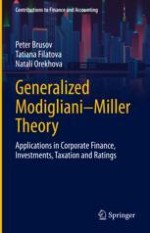The original theory of capital cost and capital structure put forward by Nobel Prize Winners Modigliani and Miller has since been modified by many authors, and this book discusses some of them. The book’s authors have created general theory of capital cost and capital structure – the Brusov–Filatova–Orekhova (BFO) theory, which generalizes the Modigliani–Miller theory to encompass companies of an arbitrary age (and arbitrary lifetime). Despite the availability of this more general theory, the classical Modigliani–Miller theory is still widely used in practice. In this book, the authors for the first time generalize it for cases of practical relevance: for the case of variable profit; for the case of advance tax-on-profit payments and interest on debt payments; for the case of several tax-on-profit and interest on debt payments per period; and for the combination of all three effects. These generalizations lead to valuable theoretical results as well as significantly widen of practical application this theory in practice and increase of the quality of finance management of the company. As well, the book investigates the applications of said results in corporate finance, investments, taxation and ratings, where employing a generalized Modigliani–Miller theory can be very fruitful.
